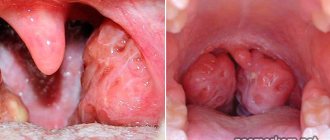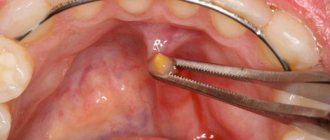Acute infectious diseases often have the greatest impact on the upper respiratory tract, namely the oropharynx, which, in turn, responds with unpleasant painful sensations, and often breathing with the smell of pus . Bad odor is usually caused by inflammation of the tonsils, also called tonsils .
In this material we will talk in detail about why bad breath appears with tonsillitis, and what ways you can fight it.
note
- Privacy Policy
Diagnostics
Traffic jams in themselves are not a disease, but only its consequence.
It is necessary to determine the causes and treatment of the disease that provoked the formation of a plug in the tonsils. You can independently detect a blockage in the tonsils by examining your own throat and comparing it with photographs showing what the blockages look like.
An otolaryngologist only needs to look at the patient's throat to make a diagnosis.
The doctor will also interview the patient, paying attention to symptoms. Additionally, an ultrasound and a throat smear may be required to determine the nature of stones in the lacunae
The problem of congestion in the tonsils in children is solved by a pediatrician - a pediatrician or a pediatric otolaryngologist. After an examination, the doctor prescribes treatment that will help both get rid of the tonsil blockage and prevent their reoccurrence.
For an experienced doctor, identifying tonsillitis is not particularly difficult. The disease is accompanied by redness and swelling of the tonsils, the presence of plugs with an unpleasant odor in their lacunae, and enlarged lymph nodes located on the neck near the ears.
But, since the causative agent of pathology can be a variety of microorganisms, it is important to determine which one among them caused the disease. After identifying the pathogen, it becomes clear to the doctor which medicine is best to use to combat a particular microorganism
Therefore, if tonsillitis appears, you should definitely consult a doctor and undergo all the necessary tests. A blood test will indicate the presence of the disease by the following indicators:
- Increased level of leukocytes (up to 20*109/l or more).
- Increase in ESR (up to 40-50 mm/hour).
- A large number of immature leukocytes.
Reasons for the appearance of a purulent odor during inflammation of the tonsils
Why does my breath smell when I have tonsillitis? The tonsils, which have natural depressions or lacunae, absorb most of the pathogenic bacteria - pathogenic microorganisms, while retaining the remnants of their vital activity, decomposing pieces of food and particles of dead cells of the tissues of the oral cavity. This is exactly how unpleasant clots appear on the tonsils, causing over time the appearance of a purulent odor.
The inflammatory process can occur for various reasons (hypothermia; bacterial or viral infections; dental diseases and much more), but the consequence of this most often is the formation of purulent plugs in the lacunae of the tonsils . It is from them that the unpleasant odor of pus comes from the mouth. In advanced forms of the disease, these plugs turn into almond stones : they harden in the lacunae of the tonsils when calcium salts are deposited. Often patients can see them with their mouths wide open: white calcified deposits appear on the inflamed tonsils, which give off an unpleasant odor.
What do tonsil plugs and stones look like?
How can you gargle to remove bad breath? Folk and medical remedies
Gargling helps relieve bad breath from the throat. You can use special medicinal solutions, for example, furatsilin or rotokan. It is recommended to rinse not only the mouth cavity with such solutions, but also the throat itself several times a day. Furacilin or rotokan must be used daily for a week.
The drug Miramistin is another effective remedy that eliminates inflammatory processes and a specific odor. Typically, this solution is prescribed for sore throats: it has a powerful antibacterial effect. It can be used in the form of a spray, as well as in the form of rinses.
Folk remedies can also help get rid of unpleasant odors. So, you can regularly treat the oral cavity with chamomile decoction, which will not only eliminate the odor, but also relieve the inflammatory process.
A decoction of sage has a similar effect. To enhance the effect, it is recommended to add a few drops of tea tree essential oil to the herbal decoction, which will also perfectly disinfect the oral cavity.
Please note that with this phenomenon, you can not only gargle, but also wash out purulent plugs (if any) from the syringe, and you can use regular saline solution or miramistin
How can a doctor help?
Treatment of tonsillitis must be carried out comprehensively. Before prescribing medications, the ENT doctor will remove plugs from the tonsils using a blunt spatula or a special irrigator. This device is intended for washing the affected lacunae with a stream of medicinal solution.
After this, the patient may be prescribed the following treatment:
- Physiotherapy, phonophoresis.
- Rinse with medicinal solutions.
- Antifungal or antibacterial drugs.
If conservative therapy methods do not help, and the inflammation begins to spread to surrounding tissues, the patient is prescribed an emergency surgical operation called tonsillectomy. The tonsil removal procedure is performed under local or general anesthesia.
After the operation, the patient is prescribed a special diet that excludes foods that irritate the operated tissues and slow down their healing process. Also in the postoperative period you should avoid alcohol, taking hot baths and playing sports.
Why does my breath smell after a tonsillectomy?
There are situations when patients still continue to be bothered by bad breath after tonsil removal. It would seem that the surgeons removed the affected tissue and got rid of the purulent plugs in the oral cavity, why is the patient’s breathing still unpleasant?
The causes of bad breath after tonsillectomy can be:
- Non-healing wounds in the postoperative period;
- Removal of tonsils was accompanied by complications, and new harmful microorganisms accumulate in place of tissue remains;
- The cause of bad breath is another disease.
The final diagnosis, which may not be related to tonsillitis, can only be made by a doctor, who will prescribe further measures to eliminate the root cause of bad breath.
How to prevent odor?
Regular preventive measures will help prevent or remove bad breath:
Everyday hygiene procedures in the morning and evening - brushing your teeth for at least 4-5 minutes, cleaning your tongue with a special scraper, using rinses, using an irrigator, floss or brush. A toothpaste with a therapeutic effect and a brush with a hardness that matches the sensitivity of your teeth. After each meal (even light snacks), floss, rinse your mouth, and after hard foods, brush your teeth additionally. Compliance with the drinking regime - drink at least 2.5 liters of liquid (filtered water, still mineral water). Balance your diet - a minimum of fatty, spicy, salty foods, a maximum of healthy, vitamin-rich foods. Give up bad habits - smoking, drinking alcohol. Make it a rule to get examined by a dentist once every six months. At the first sign of a stale aroma, pay attention, after which it appears. If the smell does not go away, go to the doctor for a consultation so as not to miss a serious pathology. In the presence of chronic diseases, it is necessary to carry out a course of medical therapy under the supervision of the attending physician, so as not to bring the body to a critical state. The problem of bad breath haunts almost the entire population of the world
It is often quite simple to deal with it by brushing your teeth with a refreshing paste on your toothbrush. However, in some situations, if the smell thins out the aroma of rot, this is quite difficult to do. This disease is called halitosis, and by its nature it causes its owner not pain, but psychological problems, sometimes leading to depression.
The problem of bad breath plagues almost the entire population of the world. It is often quite simple to deal with it by brushing your teeth with a refreshing paste on your toothbrush. However, in some situations, if the smell thins out the aroma of rot, this is quite difficult to do. This disease is called halitosis, and by its nature it causes its owner not pain, but psychological problems, sometimes leading to depression.
That is why the putrid smell should be gotten rid of immediately in order to lead a normal personal life and good communication. To do this, the first thing you should do is find out the root cause of such an unpleasant odor and the possibility of curing it.
Professional methods: removing plugs and rinsing lacunae
Having figured out how to get rid of the smell of unhealthy tonsils on your own, you should consider the methods offered by otolaryngologists.
First of all, in case of chronic tonsillitis, lavage of lacunae is indicated. This procedure is carried out using a special syringe with a curved tip, or a vacuum device for cleaning the tonsils. The essence of the procedure is to irrigate the cavities in the tonsils with an antiseptic solution. Most often, doctors use a solution of furatsilin.
Note! Rinsing the lacunae will not only help remove the odor from the tonsils, but also get rid of chronic tonsillitis. Plugs in gaps must be removed. They are an accumulation of waste products of pathogenic bacteria and cause a putrid odor from the oral cavity
To remove plugs, doctors use the same syringe with a curved tip, as it is convenient for them to break up the solid contents of the lacunae. A more gentle method is vacuum cleaning. A vacuum nozzle is applied to the lacuna, which literally pulls out the plugs. Then the depressions are irrigated with an antiseptic solution, and at the end the doctor lubricates the tonsils with Lugol
They are an accumulation of waste products of pathogenic bacteria and cause a putrid odor from the oral cavity. To remove plugs, doctors use the same syringe with a curved tip, as it is convenient for them to break up the solid contents of the lacunae. A more gentle method is vacuum cleaning. A vacuum nozzle is applied to the lacuna, which literally pulls out the plugs. Then the depressions are irrigated with an antiseptic solution, and at the end the doctor lubricates the tonsils with Lugol
Plugs in gaps must be removed. They are an accumulation of waste products of pathogenic bacteria and cause a putrid odor from the oral cavity. To remove plugs, doctors use the same syringe with a curved tip, as it is convenient for them to break up the solid contents of the lacunae. A more gentle method is vacuum cleaning. A vacuum nozzle is applied to the lacuna, which literally pulls out the plugs. Then the depressions are irrigated with an antiseptic solution, and at the end the doctor lubricates the tonsils with Lugol.
Washing lacunae at home
A syringe with a curved tip can be easily purchased at any pharmacy, so rinsing the lacunae can be done at home. True, at home it is forbidden to insert the tip into the lacuna itself, otherwise there is a risk of injury to it, which will only aggravate the problem.
It is necessary to draw a solution of furatsilin into the syringe, place the tip opposite the recesses, and irrigate the lacunae with the solution, spitting it as it flows into the mouth.
At home, you can also use an irrigator with a special attachment. The sequence of action is the same: the device is filled with an antiseptic solution, the tip is brought as close as possible to the recesses of the tonsils, and then irrigated with the medicine.
At the end of the procedure, the tonsils should also be lubricated with Lugol - this will help prolong the effect of rinsing and prevent the re-formation of plaque.
Causes of unpleasant odor
Bad odor is not caused by the tonsils themselves, but by the microbes that infect them.
The main cause of unpleasant odor in people with pathologies of the tonsils is the inflammatory process in the organ. The structure of the tonsils is heterogeneous; the organ has small depressions and depressions called lacunae. With tonsillitis, the tonsils become covered with a white coating, and the lacunae become clogged with waste products of pathogenic microorganisms - this is how plugs are formed.
In fact, bad breath is not because of the tonsils, but because of the bacteria that multiply in them. Bad breath and putrid odor are just minor symptoms of the disease. A patient with chronic tonsillitis feels unwell due to a sluggish infectious process - severe fatigue, loss of strength, poor sleep. Even a slight weakening of the immune defense can cause the disease to worsen and cause symptoms of acute tonsillitis.
Thus, the smell is only a consequence of a malfunction of the organ. The problem must be dealt with comprehensively.
Causes of halitosis in children
Young children also suffer from bad breath. The medical term for this symptom is halitosis. Children often forget to take care of their oral hygiene.
Therefore, parents are obliged to supervise timely bathing procedures and explain to the child the importance of hygiene. But there are times when the symptom is not related to hygiene
For example, tonsillitis and bad breath are very often interrelated. Other diseases of the ENT organs that provoke the appearance of an unpleasant odor:
- pharyngitis;
- rhinitis;
- sinusitis;
- adenoiditis.
Another cause of the symptom is diseases of the teeth and gums:
- caries;
- stomatitis;
- gingivitis;
- periodontitis.
Diseases of the internal organs also cause odor:
- gastritis;
- ulcer;
- kidney and liver diseases.
The problem is also provoked by diabetes mellitus and increased acetone in the blood. But, according to doctors, it is mainly chronic tonsillitis that causes bad breath. There is no need to sound the alarm when halitosis appears only in the morning or is felt during very close contact. This is the norm. Halitosis can also be short-lived. This is due to eating garlic, onions, and sweets. Imbalance of oral microflora is caused by the following factors:
- fungal infection in the oral cavity;
- malfunction of the salivary glands;
- increased acidity;
- mental health disorder - rumination.
There are cases when halitosis appears in newborns. Why does it occur:
- Dysbacteriosis. Appears when feeding infants with infant formula or during treatment with antibiotics.
- Poor oral hygiene during teething.
If a patient has a sore throat and bad breath, one may suspect that the cause is a sore throat or tonsil blockages. How to get rid of this problem? Quite often there are cases when plugs are removed from a patient’s throat with a finger or with a cotton swab at home. This method is dangerous and will only worsen the situation. Moreover, traffic jams are a consequence of a disease that requires medical intervention.
Tonsillitis: signs of the disease
To understand the nature of the appearance of severe bad breath due to inflammation of the mucous membrane of the pharynx, you should know how the disease develops. As a result of inflammation of the tonsil gland (palatine or pharyngeal tonsils), a person is overcome by either acute tonsillitis - that is, tonsillitis , or after a long course of the acute phase of the disease with a number of complications chronic tonsillitis . The latter can develop after suffering acute diseases such as diphtheria, measles or scarlet fever.
To understand the process of the occurrence of unpleasant odor emanating from the oral cavity, it is worth familiarizing yourself with the principle of operation of the tonsils and finding out why they become inflamed. The tonsils take on part of the work of the immune system: in combination with other lymphoid formations, they protect against pathogenic microorganisms that enter the human body through airborne droplets. Depending on the general state of the immune system, the tonsils may not cope with their main function - to protect the body from infection, as a result of which tonsillitis occurs.
Having fallen ill with one of the forms of tonsillitis, inflammatory processes in the tonsil area will make themselves felt with a noticeable local symptom: first of all, the patient will feel pain in the palatine part of the mouth . The disease also has another unpleasant symptom: with tonsillitis, a bad breath appears that resembles the smell of pus. That is why the most common complaints from patients in this regard are as follows: “sore throat, bad breath.”
How to determine that a patient has tonsillitis?
- smell of pus from the mouth;
- acute pain when swallowing saliva, most often in the morning;
- cough that makes itself felt in attacks;
- a feeling that there is something in the throat;
- general malaise;
- headaches, neck or ear pain;
- increased sweating;
- increase in temperature at night;
- white clots on the tonsils.
Elimination methods
The smell can appear for two reasons:
- Inflammation of the tonsils as a result of a cold - tonsillitis.
- After partial removal of the tonsils, this condition is short-lived and disappears after 1 week.
Methods for eliminating unpleasant odors include:
- rinsing the nasopharyngeal cavity with disinfectant solutions (for example, saline solution or weak herbal decoctions);
- daily oral hygiene procedures: brushing teeth, using dental floss and mouthwash;
- remove inflamed tonsils surgically.
It will not be possible to mask the “stench” with aromatic preparations.
Medical therapy
Treatment therapy includes:
- mouth rinse;
- the use of aseptic solutions for rinsing the nasopharynx;
- remove or treat teeth damaged by caries;
- get rid of completely damaged teeth;
- attend physical therapy;
- use homeopathic therapy.
Mechanical impact
Mechanical action refers to the physical removal of formed plugs. This procedure takes place, but you should not carry it out yourself, removing plugs from the mucous membrane. This method increases the risk of re-infection of existing open wounds.
The lacuna can be cleaned of purulent contents only by an otolaryngologist, where all sanitary and preventive measures will be observed.
If it is impossible to use a conservative method of odor elimination or if there is no effect, the issue of complete or partial removal of the tonsils is decided.
Rinsing
A common and inexpensive way to get rid of unpleasant odor is to use mouth rinse solutions.
- Saline solution. Stir half a teaspoon of table salt in a glass of warm water. Use up to 6 times a day. This solution helps eliminate persistent odor and also provide an aseptic effect on the entire oral cavity.
- Medicinal plants - decoctions from them. Most medicinal plants have a bacteriostatic, disinfectant effect. To prepare a decoction for the unpleasant odor and the periodic appearance of hard accumulations on the tonsils, you will need chamomile, linden and St. John's wort inflorescences (1 tablespoon of each plant). They should be boiled using approximately 1 glass of water. Rinse your mouth with the decoction and irrigate the nasal cavity every 3 hours.
Cryotherapy
A new trend in medicine that allows you to eliminate unpleasant oral odor caused by chronic or acute tonsillitis.
Cryotherapy is a therapy using a cryostat - a device with an extremely low temperature that “freezes” the tonsils or part of them. The effectiveness of cryotherapy has fully met the expectations of people who are tormented by the smell of bad breath. 3 sessions are enough to completely get rid of the disease.
Prevention
Timely prevention will reduce the risk of developing tonsillitis. To do this, you must adhere to some rules:
- Lead a healthy lifestyle, giving up smoking, drinking alcohol, and giving preference to sports.
- Rinse your mouth after every meal.
- Visit the dentist's office at least 2 times a year, and more often if necessary.
- Observe oral hygiene rules.
- Use zinc-based mouthwash and sodium chloride.
- Strengthen immunity:
- Drink at least one and a half liters of still water per day.
- Maintain a sleep-wake schedule.
- Watch your diet, be sure to eat fruits, vegetables and meat products.
How to remove and get rid of the smell of tonsillitis from the mouth?
Methods for getting rid of bad breath caused by the presence of chronic tonsillitis are quite real. To do this, the patient can resort to the use of conservative treatment methods in the form of taking tablets or injectable antibiotics, or regularly gargle with antiseptic solutions. The most popular and effective are the following methods for eliminating putrid odor from the mouth.
Saline solution
Everyone knows that salt is a natural preservative that can destroy all bacterial microflora in a matter of minutes. Salt destroys protein compounds and thereby destroys all available foci of infectious inflammation. To achieve such a therapeutic effect, the patient only needs to prepare a saline solution based on the proportion that 1 teaspoon of salt should be added to 1 glass of warm water. After this, a banal gargling is performed for 5-10 minutes. The saline solution reduces the number of bacteria, relieves infectious inflammation and, as a result, the putrid odor goes away. The method is very simple and easy to use at home.
Decoctions of medicinal herbs
It is also an equally effective method of combating the manifestation of such a symptom of tonsillitis as bad breath. The patient needs to boil 15 grams of chamomile, coltsfoot, plantain or St. John's wort in 1 liter of water. The boiling process continues for 15-20 minutes. After this, the broth should cool down and you can begin to get rid of the smell of rot from the oral cavity. A decoction of medicinal herbs has a specific smell and bitter taste, but this is the only drawback of this remedy for bad breath.
Washing lacunae
There are special drugs with an antibacterial spectrum of action that are administered directly into the lacunae. The procedure is performed in the office of an otolaryngologist and is aimed at washing out purulent plugs from the tonsils in order to neutralize the source of infection and, accordingly, the putrid odor from the oral cavity.
The type of medication is selected individually based on the results of a bacterial study of the microflora that parasitizes on the surface and in the tissues of the tonsils.
Lugol smudging
To eliminate bad breath caused by the presence of chronic tonsillitis in the tonsils, it is necessary to lubricate the tonsils with Lugol's solution in the morning and evening. To do this, you need to moisten a cotton swab with this drug and carefully wipe off the bacterial plaque that has accumulated on the surface of the tonsils. By using this procedure, it will be possible to simultaneously remove putrid odor from the mouth and suppress the activity of bacterial microflora.
Rinse with Furacilin
This is another simple and effective method of eliminating bad breath, the appearance of which is caused by the patient having chronic tonsillitis. The patient needs to take 1 tablet of Furacilin, crush it until it turns into powder. Then the crushed tablet is dissolved in a glass of warm water. Gargling is performed in the morning and evening for 5-7 days. This is the optimal length of time during which you can quickly remove bad breath, as well as stabilize the microflora in the oral cavity. It is not recommended to gargle with Furacilin solution for longer due to the fact that bacteria may become addicted to this type of antibiotic.
Chlorine dioxide rinse
This method of getting rid of putrid odor is that a patient with chronic tonsillitis uses a medical solution of chlorine dioxide to antiseptically rinse the diseased tonsils. As soon as there is a suspicion that an unpleasant odor begins to emanate from the mouth, you should rinse your throat and the oral cavity directly for 1-2 minutes. Your breath will immediately become fresh, and the positive results will last for several hours.
Sodium chloride solution with zinc
A medical solution for gargling a sore throat, which is sold in almost every pharmacy. Intended for systematic use when a person has bad breath caused by a disease such as chronic tonsillitis. You can also use this drug if necessary, if suddenly the bacteria parasitizing in the tonsils become more active and an unpleasant odor appears from the oral cavity. Rinsing is done no more than 3 times a day.
How to get rid of unpleasant odor due to tonsils?
Bad breath is a consequence of damage to the tonsils by pathogenic bacteria. To make your breath fresh, it is necessary to eliminate discharge and plaque from the tonsils associated with an unpleasant odor.
At home, it is suggested to use various solutions for gargling.
Important! To ensure that the effect does not take long to appear, you need to gargle 3-4 times a day.
The advisability of using sprays and lozenges for a sore throat depends on whether there are other unpleasant symptoms. Rinsing is more effective because it washes away plaque from lacunae, while sprays and lozenges only temporarily eliminate pain.
Saline rinse
When there is an unpleasant odor, the tonsils are covered with plaque, and there are no special remedies at hand, simple salt will come to the rescue. However, it is better to use iodized or sea salt for rinsing. To prepare the solution, you need to thoroughly mix 1 teaspoon in a glass of water at a comfortable temperature (37-38 degrees). Then gargle, keeping one portion of the solution in your mouth for at least 30 seconds.
It is recommended to repeat the procedure every 4 hours in the first 2 days of treatment, then 3 times a day.
Decoctions for rinsing
Sage herb is a very good folk antiseptic.
The goal of treatment is to get rid of foul-smelling discharge from the tonsils. To do this, you need to gargle with products with antiseptic properties, otherwise the water will only temporarily clear the gaps, but after a few hours the plaque will return.
Among folk remedies, it is suggested to use decoctions of chamomile, calendula or sage. To prepare the medicine, you need to take a large spoon of the raw material and add 300 ml of water. Cook over low heat for 15-20 minutes, then cool and strain.
Note! Herbal decoctions can stain the enamel yellowish, so after rinsing it is recommended to brush your teeth and rinse your mouth thoroughly with clean water.
The resulting decoction is diluted in half with water. The amount of medicine prepared according to the prescription is enough for 3-4 rinses.
Lugol's solution
Lugol's solution will help eliminate bad breath due to inflamed tonsils with tonsillitis. You can buy it at any pharmacy. The product has a powerful antiseptic effect. The solution can be used as an independent remedy, lubricating the tonsils with it 2-3 times a day, or as an aid to rinsing. In the latter case, the solution is applied to the tonsils after gargling.
Otolaryngologists use this remedy to reduce the risk of infection of the tonsils after manipulations, for example, washing lacunae. Lugol not only eliminates bacteria already present on the tonsils, but also prevents their spread or re-infection.
The product is applied to the tonsils using a cotton swab.
Furacilin
The tablets must first be dissolved in warm water.
The unpleasant odor of unhealthy tonsils can be eliminated with the help of antibiotics. Potent drugs in tablets are not used without a doctor’s prescription, but simple drugs such as Furacilin can be freely used before visiting a doctor.
To prepare the solution, you need to crush one tablet of the medicine into powder and dissolve it in a glass of water. The tablets are very hard, so it is recommended to use a mortar. Another simple option is to place the tablet in a spoon, cover it with the back (convex) side of the second spoon and press firmly. The tablet will immediately turn into a yellow powder, which can only be poured into water.
The rinse solution should be warm - about 37 degrees. The procedure should be carried out twice a day.
Chlorine dioxide
If your tonsils smell unpleasant and bad breath deprives you of self-confidence, it is recommended to purchase a chlorine dioxide solution at the pharmacy. This is a powerful antiseptic that effectively cleanses plaque from the tonsils and makes your breath fresh.
Chlorine dioxide is used as first aid against plaque, but is not suitable for constant use, as it dries out the mucous membranes greatly.
To remove unpleasant plaque from the tonsils and bad breath, you need to take a little chlorine dioxide solution into your mouth and gargle thoroughly for 2-3 minutes.
Sodium chloride with zinc
Sodium chloride solution is a saline solution that can be purchased at any pharmacy. Also, all pharmacy chains offer a solution with zinc, which has a powerful antiseptic effect. This product can quickly remove the smell of tonsils and will help get rid of plaque in the shortest possible time.
There is no need to dilute the prepared solution; it is used in its pure form. Rinsing is carried out for several minutes, the procedure must be repeated three times a day.
Elimination methods
In addition to physiotherapy and medications, other methods of therapy should be used. Getting rid of tonsillitis and avoiding surgery is possible only with careful daily treatment, which may include the use of Lugol, saline solutions, chlorine dioxide, Furacilin, as well as decoctions prepared from medicinal plants.
Decoctions of medicinal herbs
Plant decoctions can be used as a gargle or taken orally, as many herbs have antifungal, anti-inflammatory and antibacterial effects.
Such plants include:
- Black currant leaves.
- Pharmaceutical camomile.
- Calendula.
- Sage.
- Raspberry leaves.
- Liquorice root.
- Eucalyptus leaves.
- Celandine (use only for rinsing).
- Viburnum fruits.
- Fireweed.
- Rhizome of meadow geranium.
- Coltsfoot.
- Plantain.
When preparing teas from the listed plants, it is recommended to add honey to them, since it is very useful for tonsillitis.
Saline solution
A solution of salt and water is an effective remedy that eliminates purulent formations and cleanses lacunae from infection. To completely eliminate the unpleasant odor caused by tonsillitis, it is recommended not only to gargle with this solution, but also to rinse your nose. This will clear the nasal passages of mucus, which contains bacteria coming from the lacunae of the tonsils.
Lugol smudging
After gargling, it is useful to lubricate the tonsils with Lugol's solution. This product has an antiseptic effect and effectively fights bacterial and viral infections, intestinal bacteria and viruses, fungi, and staphylococcus.
It should be borne in mind that Lugol should not be used by people suffering from thyroid diseases, as well as for the treatment of infants. This product should only be used by nursing mothers after consulting a doctor.
Washing lacunae
You can wash the lacunae with black radish juice, furatsilin, a solution of colloidal silver, a solution of propolis and alcohol, and herbal infusions.
You can also use an infusion of golden mustache, as this plant has powerful bactericidal properties. To prepare the infusion you will need 200 g of boiling water and a large leaf of the plant. The golden mustache is infused in a thermos for 2 hours, after which it is used for its intended purpose. Washing lacunae with this product should be carried out for 10-12 days.
Rinse with Furacilin
Furacilin has a pronounced antiseptic, wound-healing and antimicrobial effect. The drug very effectively eliminates the symptoms of tonsillitis of any type - catarrhal, follicular, ulcerative film or lacunar.
Furacilin solution should be used 2-3 times a day. After rinsing, do not eat or drink for an hour.
Sodium chloride solution with zinc
A solution of sodium chloride and zinc has a good effect in the treatment of tonsillitis. Sodium chloride is a common salt that has an antiseptic, healing and antiviral effect, eliminates swelling and inflammation. Zinc effectively fights purulent wounds, accelerates their healing process, and eliminates bad breath.
Chlorine dioxide rinse
The use of rinses containing chlorine dioxide helps eliminate unpleasant odors and sulfur deposits from the mucous membranes and tonsils. This effect is due to the ability of chlorine dioxide to effectively destroy bacteria that cause an unpleasant odor.
Categories
AllergistAnesthesiologist-resuscitatorVenereologistGastroenterologistHematologistGeneticGynecologistHomeopathDermatologistPediatric gynecologistPediatric neurologistPediatric urologistPediatric surgeonPediatric endocrinologistNutrologistImmunologistInfectious disease specialistCardiologistCosmetologistSpeech therapistElorologistMammologistMedical lawyerNarcologistNeurologistNeurosurgeon NephrologistNutriciologistOncologistOncourologistOrthopedist-traumatologistOphthalmologistPediatricianPlastic surgeonProctologistPsychiatristPsychologistPulmonologistRheumatologistRadiologistSexologist-AndrologistDentistTherapistTrichologistUrologistPharmacistPhytotherapistPhlebologistSurgeonEndocrinologist
Tonsillitis bad breath how to deal with it
An unpleasant odor is a consequence, but we must fight the cause. Therefore, if a problem occurs, you should visit a doctor who will prescribe appropriate treatment. The following methods can be used at home:
- cleaning the mouth, tongue and teeth;
- regular mouth rinsing;
- cleaning the sinuses and tonsils.
Removing tonsil plugs at home is dangerous; you need to visit a doctor who will do it professionally and without threatening your health. Gargles also help remove purulent stones from the throat and get rid of unpleasant odor. Although this takes time. You should rinse your mouth regularly - 3-6 times a day. What means are used:
- Salt and soda. Dose - half a teaspoon per glass of warm water. Water should be taken purified.
- Herbal decoctions. Many herbs have antiseptic and antibacterial effects. They can be used separately and in herbal preparations. The most effective plants: chamomile, linden, St. John's wort, celandine, plantain. Pour a glass of boiling water over a spoonful of the plant, let it brew and strain.
- Pharmacy drugs. Use: chlorine dioxide, sodium chloride solution with zinc, furatsilin. Furacilin is sold in tablet form. Before use, one tablet should be thoroughly crushed and completely dissolved in a glass of water.
Lubricating the tonsils with Lugol's solution will help get rid of the unpleasant odor. This procedure will temporarily eliminate halitosis and reduce bacterial activity. In the doctor's office, you can perform a procedure for washing the lacunae using special medications. But all these procedures are ineffective if the main source of infection is not treated. Therefore, depending on the pathogen, the doctor prescribes antibiotics, physiotherapeutic procedures and homeopathic medicines. If the disease is very advanced and drug therapy does not produce results, the only option is surgery:
- complete removal of tonsils;
- partial removal of affected areas of the tonsils;
- cryotherapy is the effect of low temperatures on the tonsils, as a result of which diseased cells die.
Unfortunately, in some cases, even surgery is useless. This happens when the infection has spread not only to the tonsils, but to other organs and tissues.
How to get rid of bad breath with tonsillitis?
Treatment of minor symptoms (such as unpleasant breathing) is unacceptable for tonsillitis, since inflammation of the tonsils and the chronic form of the disease can lead to very serious health problems: give complications to the heart, kidneys, thyroid gland, joints and blood vessels, and, of course, while a person is sick, the smell will not disappear, even if you try to mask it.
How to get rid of tonsillitis and bad breath? There are several ways to combat this disease.
Treatment with traditional methods
And although drug intervention for tonsillitis is called treatment, it is rather superficial in nature, since it cannot completely relieve the patient of the disease in a severe stage. It is important to understand that the methods presented below only inhibit the development of the disease, and also involve temporary elimination of symptoms , but cannot relieve the patient of the most important problem - the elimination of purulent stones and foci that cause an unpleasant odor.
- Local use of antiseptic drugs
To do this, you can rinse your mouth with Lugol, tincture of iodine, iodine glycerin, saline solution, decoctions of chamomile, linden, celandine or St. John's wort (you will need to infuse 2 teaspoons of the herb in 1 cup of boiling water for 30 minutes).
- Antibiotic therapy
The doctor prescribes a course of medication to combat tonsillitis, selecting the necessary antibiotic depending on the causative agent of the disease. The most common type of pharmacological drugs is protected penicillins.
- Physiotherapy
An ENT specialist can prescribe procedures that will help have a beneficial effect on inflamed tonsils: phonophoresis, ultraviolet light, diameter or laser.
- Antiseptic lavage of lacunae
A similar procedure temporarily saves you from bad breath: while rinsing the mouth, the grooves in the tonsils are washed with Miramistin, Furacilin or Chlorhexidine.
- Solving dental problems
Sometimes bad breath and sore throat, and then an inflammatory process that turns into tonsillitis, can be caused by diseases of the teeth or gums. Eliminating these problems will significantly alleviate the problem with bad breath, and also get rid of infectious foci that irritate the tonsils.
Important! Self-exposure to tonsil plugs and stones without the supervision of a medical professional can aggravate the situation . You should not touch the affected tissues with your fingers, ear sticks or other objects: there is a risk of introducing additional bacteria into the resulting wound, as well as damaging healthy tissues, which will only expand the affected area with tonsillitis.
Surgical intervention
Removing tonsils is a popular topic of discussion among various medical professionals, however, with advanced tonsillitis, doctors can resort to this method. The so-called tonsillectomy , that is, an operation to completely remove the tonsil, is now performed only in severe stages of tonsillitis with complications. Often, surgeons remove only the areas of the tonsils in the mouth that are most affected—this type of surgery is called a tonsillotomy . This procedure is considered the most gentle for the patient, since recovery after such an intervention occurs quite quickly, and the organ in the oral cavity partially continues to perform its protective function.
When is a tonsillectomy prescribed?
- in cases of frequent relapses of tonsillitis - from four times a year;
- in case of complications of the disease affecting other vital organs of the patient;
- when the process of decay moves from the tonsils to other areas of the oropharynx;
- in situations where traditional treatment for tonsillitis does not produce a positive effect.
Types of tonsillectomy:
- Classic way . Surgeons use special loops, a scalpel and scissors. This method of treating tonsillitis in comparison with modern procedures is considered less practical: it involves a high degree of trauma to the oral cavity and a long postoperative recovery period;
- Laser removal . This method of dealing with tonsillitis is considered more acceptable in our time, since it does not involve pain during the operation and a long recovery period after it, as well as swelling after completion of the procedure. The downside is the risk of burning healthy tissue in the mouth area;
- Ultrasonic scalpel . This method of combating tonsillitis provides for a quick recovery period after surgery.
- Surgitron (radio knife) . This method has its pros and cons: the intervention takes place without heating the tissues in the oral cavity, but anesthesia is required for its use.
Complete removal of tonsils helps completely eliminate the cause of bad breath. Whereas partial removal of the affected tissue can also relieve the patient from the source of the disease and bad breath with purulent notes, but at the same time preserve part of the organ.
Cryotherapy against purulent plugs
In case of chronic tonsillitis, there is another way to remove bad breath. One of the most popular types of tonsillotomy , that is, partial removal of the tonsils, is now considered cryotherapy . Cryosurgery in the fight against tonsillitis involves a destructive effect on the affected tissue using extremely low temperatures . After several procedures, foci of inflammation are destroyed and die.
Related and recommended questions
What to do with chronic tonsillitis? I have chronic tonsillitis, I went to see...
Tonsillitis, pharyngitis, unpleasant odor. Tell me what to do. Constantly from the tonsils...
Mucus in the throat, sore throat, fever. I am diagnosed with chronic tonsillitis. Unpleasant…
Pus is coming out of the tonsils. Doctor a month ago I started having a severe runny nose and sore throat...
Tonsillitis? Can I have chronic tonsillitis if I don’t get tonsillitis? Or chron...
Tonsillitis was not cured by Azithromycin Irina Yurievna! I have chronic tonsillitis...
Bad breath Please tell me what to do The thing is that I have had this for a very long time...
Constant sore throat and malaise. Is this chronic tonsillitis? I am 16.5 years old...
Exacerbation of chronic tonsillitis A little over a year ago I was diagnosed with chronic...
Chronic tonsillitis, how to treat Please help, I don’t know what to do anymore, recently...
Chronic tonsillitis, filling in the maxillary sinus Irina Yurievna. I will be very grateful to you...
Chronic tonsillitis does not go away for 2 months, problems with the throat, diagnosed with chronic...
Chronic tonsillitis with severe hypertrophy photo Doctor, please tell me...
Sore throat throughout the year For about a year I have noticed that there is constant discomfort...
Chronic tonsillitis, sore throat, inflammation of the tonsils. I’ve been suffering from…
Inflammation of the tonsils or tonsillitis Doctor! A few years ago I discovered in my...
What's wrong with my throat? Some kind of trouble in the mouth and throat. What does it look like, does it need treatment?...
Sore throat or whatever God bless you. I have this problem, 2 years ago I had a sore throat...
Chronic tonsillitis and I am very suffering from such a disease as chronic tonsillitis….
Large tonsil cyst Irina Yurievna. A couple of years ago I had two small cysts...










